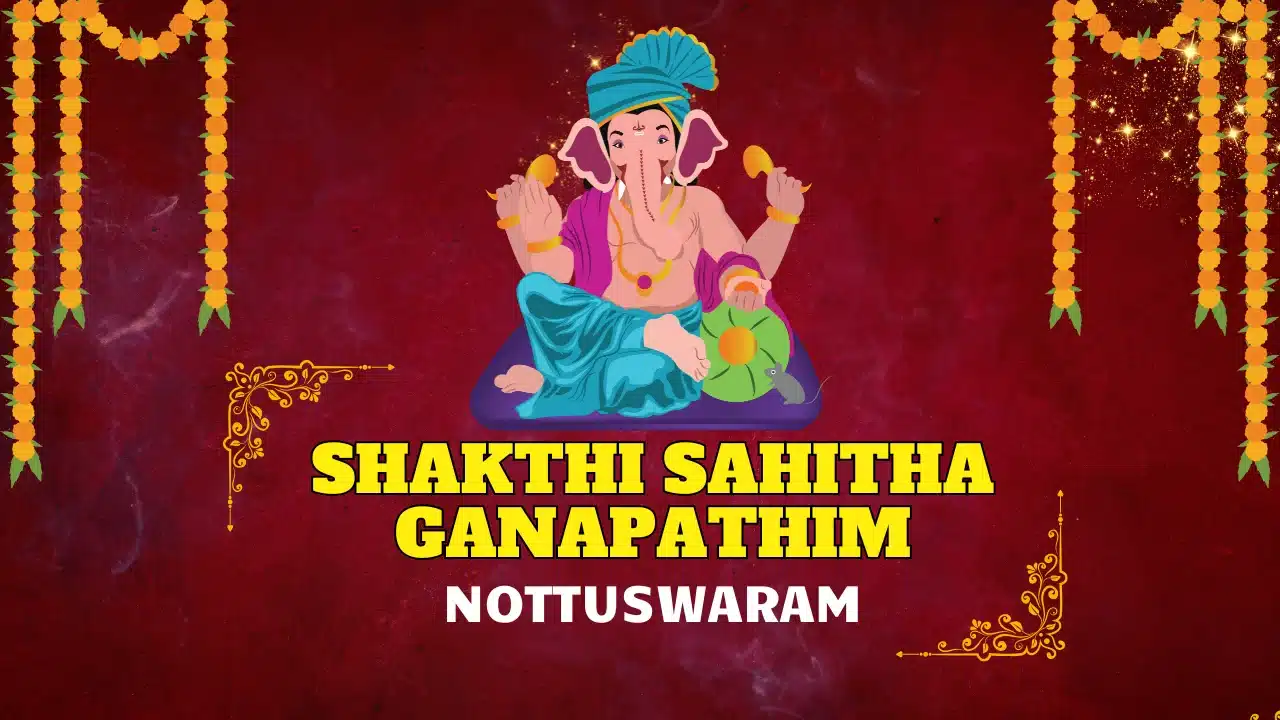- Shakthi Sahitha Ganapathim Composer – Dikshidar
- Nottuswaram
- Shakthi Sahitha Ganapathim Significance
- Shankarabharanam Raaga
- Shakthi Sahitha Ganapathim Notations
- Shakthi Sahitha Ganapathim | Nottuswaram
- Shakthi Sahitha Ganapathim Lyrics
- Shakthi Sahitha Ganapathim Lyrics Meaning
- Other Devotional Tracks of Lord Ganesha
- Final Thoughts
- FAQs
Have you heard of Nottuswaras in Carnatic music? If your answer is No, think again of Shakthi Sahitha Ganapathim, which you learnt as a child. This song falls under Nottuswaram, a unique style combining notes and swaras designed by Muthuswamy Dikshadhar set in Shaknarabharanam, Adi talam.
Dikshadar- the visionary of Carnatic music who made it to the Trinity, has had many
inspirations, one of which is Nottuswaram. Let’s dive deep into the Nottuswaram of Shakthi Sahitha Ganapathim lyrics, which is etched in the hearts of Carnatic musicians because it is one of the first few songs you learn as a child and more. In this blog you will learn Shakthi Sahitha Ganapathim lyrics along with significance and nottuswaram.
Shakthi Sahitha Ganapathim Composer – Dikshidar
Born in the 18th century Muthuswami Dikshitar,has composed more than 500 songs in Sanskrit, praising gods and many life situations that he has lived through. He is mainly recognised by his Vanika (Veena in today’s terms), emphasising the nuances of gamakas. Muthuswamy Dikshadhar is derived from Muthu (Pearl in Tamil language) and Muthuswamy denotes the deity Selvamuthukumaraswam, of Vaitheeshwaran temple. Though he was born near a small town in Tanjore, he had travelled the lengths and breadths of India.
According to history, he started singing when Lord Muruga of Tiruttani, placed a piece of sugarcane in his mouth and asked to sing, his first composition being Shrinaathaadi Guruguho Jayati Jayati set in Mayamalavagowla, Adi thala (4/4 time signature in western notation). This is also the reason why most of his songs are praising this Tamil Kadavul (Muruga is referred as the Tamil God). When he came to Chennai, Muddaya (another name for Dikshadar), was inspired by Fort St. George bands who made around 39 compositions under the category, and called it Nottuswaram.
Nottuswaram
Is derived from the combination of notes and swaras. He adapted Baroque and Celtic styles showcasing western folk songs composed in Sanskrit. Most of these songs are based of Shankarabharam, the white keys of the keyboard ascending from C scale.
Most of these songs have Irish and Scottish origins where it seems like a bridge between Indian and western music in a chant style like slokas, having a distinct approach to praise the deities of varied temples. The distinct character of these songs is the lack of elaborate gamakas that ornament other krithis of Carnatic music with a striking talam structure that you can ballet to, Try it!
Shakthi Sahitha Ganapathim Significance
One of the renowned Nottuswaram is Shakthi Sahitha Ganapathim describing Lord Ganesha, who is prayed before you start anything. Being the destroyer of obstacles for a smoother path, this song is first taught in many Carnatic music, especially for children, the reason being it being simple yet fun. The rhythm keeps kids on their toes and hence it is one of the first songs you learn to dance Bharatanatyam, an Indian classical dance form, as well.
Shankarabharanam Raaga
This 29th sampoorna raga of the 72-raga Melekartha system of Carnatic music, containing all 7 notes is also called Dheerasankarabaharam. Its Hindustani music equivalent is Yaman Kalyan, incidentally the first raga taught in that style unlike Carnatic music teachers imparting Mayamalavagowla raaga.
The notes or the swaras are as follows:
Aarohanam: s r2 g3 m1 p d2 n3 S
Avarohanam: S n3 d2 p m1 g3 r2 S
The notes of Shankarabharanam raga are the lowest key, shadjam(s), chatusruti
rishabam(r2), anthara gandharam(g3), shuddha madyamam(m1), panchamam(p),
chatushruthi daivatam(d2) and kakali nishadam(n3) completed by the highest shadjam represented by S above.
This raga is versatile and can be performed in many permutations and combinations which gives birth to innumerable Janya ragas, like children, including Arabhi, Hamsadhwani, Shuddha Saveri Kurinji and Bilahari. The Shuddha Madhyamam or Ma note used in Kalyani scale is the same as Shankarabharam.
Apart from Shakthi Sahitha Ganapathim, he also composed Dakshina-moorthe, Sadasivam Upaasamahe, Akṣhaya-liṃga-vibho and Shri Kamalamba. Many other compositions like Chalamela varnam by Maharaja Swathi Thiruna, Manasu Svādhīnamaina by Saint Tyagaraja, Devi Meena-naytri by Syama Sastri and Rajeevaksha Baro by Swati Thirunal, to name a few.
In films, we would have definitely head bobbed to Paadadha Pattellam from the movie Veerathirumagan or to the ‘Adho, Andha Paravai Pola’ from Ayirathil Oruvan. Both these songs were remixed later. Other famous songs that made to the charts include Love Birds (Anbe Vaa), Nilaave Vaa (Mouna Ragam), Kanmani Anbodu Kadhalan (Guna), Netru illatha matram (Pudhiya Mugam), Pennalla Pennalla (Uzhavan), Vetri Nichayam (Annamalai), Sara Sara Saara Kaathu (Vaagai Sooda Vaa) and Rakita Rakita Rakita (Jagame Thandhiram).
If you look at the above list, you would understand how music directors have gone out of the way to explore a myriad of emotions while C Major, the equivalent of Shakarabharam scale, is mostly considered as a generic happy scale that is used to portray children rhymes and marching bands is used in a song like the old classic, Paadatha Pattellam and a funky Rakita Rakita Rakita.
Shakthi Sahitha Ganapathim Notations
Song: Shakti sahita
Raga: Dheera shankarabaranam
Tala: Thisra eka.
Composer: Muthuswamy Dikshitar
Aro: S R2 G3 M1 P D2 N3 S
Ava: S N3 D2 P M1 G3 R2 S
| G – G | G M G | R S R | S – – | N – S | R – N | S – R | G – S |
| Sha kti | sa hi ta | ga na pa | tim | shanka | ra di | se vi | tamvi |
| G – G | G M G | R S R | S R G | M – G | R G S | P S N | S – – |
| rak ta | sa ka la | mu ni va | ra su ra | ra ja | vi nu ta | gu ru gu | ham |
| R – – | N – P | S – G | R – – | R G R | N – P | S – G | R – – |
| bha | kta ni | po sha | kam | bhavasu | tam vi | na ya | kam |
| P D P | M P M | G M G | R – – | S R S | N S N | P D N | S – – |
| bhaktimu | ktipradm | bhushita | ngam | rak ta pa | dambujam | bhavaya | mi |
Shakthi Sahitha Ganapathim | Nottuswaram
Shakthi Sahitha Ganapathim is set in Tisra Eka Thalam where a unit of rhythm is divided into three equal parts. Hence, if you look at the above figure, all the swaras and notes are divided into three notes. It might sound like Adi Thalam (4/4 time signature) and can be sung in the same way but the composition structure and tune is designed in such a manner by Swamy Dikshadhar, that it is split into three notes instead of four.
Shakthi Sahitha Ganapathim Lyrics
Shakthi Sahitha Ganapathim
Shankaradhi Sevitham
Viraktha Sakala-munivara sudha
Raja vinutha Guruguham
Bhakthaali Poshagam
Bhavasutham Vinayakam
Bhukthi Mukthi Pradham Bhooshithaagam
Raktha Padaamujam Bhavayaami, Bhavayaami, Bhavayaami.
Shakthi Sahitha Ganapathim Lyrics Meaning
The song is introducing Lord Ganesha (Ganapathim) to the world, who is always seen along with (sahitha) his mother, Goddess Parvathi (Shakthi). He is showered with praises from Lord Shiva (Shankraadhi), admired by the Lord of Indra, all sages (munivara) who have renounced their materialistic lifestyle (viraktha) and the poet, Muthuswamy Dikshadhar (Guruguham). The Shakti Sahita Ganapathim lyrics meaning portray Lord Ganesha as a kind god who is always accompanied by his holy mother, Goddess Parvathi, in addition to being a remover of obstacles.
The next verse of Shakthi Sahitha Ganapathim Lyrics is from the point of view of Dikshadhar who prays (bhavayaami) to Lord Ganesha (Vinayakkam), who is known to be protector (poshakam) of his devotees (Bhakthali), the son (sutham) of Lord Shiva (Bhava), the benefactor (pradham) of happiness (Bhukthi) and salvation (moksham), who is predominantly decked in vibrant clothes (bhooshitaangam) having red (raktha, the colour of blood) feet like the lotus flower (paddambhujam).
Other Devotional Tracks of Lord Ganesha
Apart from the lovable Shakthi Sahitha Ganapathim, there are a million songs that you can choose from, to praise and tell tales of Lord Ganesha. Maha Ganapathim set in Hamsadhwani, is one of the crowd favourites to start a concert which was later inspired to suit the light music of Chennai Senthamizh in the movie, M. Kurmaran S/O Mahalakshmi. Other songs include Ganapathiye Varuvai, Vinayakane Vinai Theerpavane (Seergazhi Govindarajan), Ekadanthaya, Gajavadhana (Unni Krishnan version), and Vinayaka Nenuvina Brochudavu.
Some of the popular film songs about Lord Vinayaka are Saamy Varudhu (Udan Pirappu), Maha Ganapathi (Amarkalam) and Gajanana (Bajirao Mastani). Listen to them on popular digital platforms like Spotify, YouTube, Apple Music and SoundCloud.
Final Thoughts
Few days back, Vinayaka Chaturthi went by and we were able to hear so many songs on the road while crossing streets with temples, kids competitions and a zillion Instagram covers. Vinayaka is the favourite god for many because of his friendly and amicable nature who grants your wish in a jiffy unlike his family comprising Shiva, Parvathi and Murugan. Conditions apply!
The song, Shakthi Sahitha Ganapathim is very close to my heart, not only because it is a song that I learnt as a child, but is also the first song I sang in my debut katcheri. Set it Shankarabharanam, this short devotional number is sure to make your lips go wide with a smile feeling nostalgic moments like mine and enjoy its simplicity in this feel-good Nottuswaram, Dikshidar-style!
FAQs
What is the meaning of Shakti Sahita Ganapathim?
The meaning of Shakthi Sahita Ganapathim is ‘the beloved son of Parvathi, Lord Ganesha’. It is the poet calling out the god by describing him.
Who composed Shakti Sahita Ganapathim?
The composer of Shakthi Sahita Ganapathim is Mutthuswamy Dikshadhar who made this song as Nottuswaram.
What is the ragam and talam of Shakti Sahita Ganapathim?
This cute composition is set in Shankarabharanam, the 29th raga of Melakartha system which is Yaman Kalyan in Hindustani Classical Music.
What is the significance of Shakti Sahita Ganapathim in Carnatic music?
Apart from being a simple Ganesha song for kids to learn in Carnatic School Of Music, Shakthi Sahita Ganapathim is one of the Nottuswarams out 39 compositions crafted by Muthuswamy Dikshadhar.
How is Shakti Sahita Ganapathim performed?
Shakthi Sahita Ganapathim can be performed as a vocal acapella, or in a variety of instruments like violin, guitar, or veena. A heavy rhythm pattern would be an add on to this ensemble giving life to this waltz.
What are the lyrics of Shakti Sahita Ganapathim?
The lyrics of Shakthi Sahitha Ganapathim is as follows:
Shakthi Sahitha Ganapathim
Shankaradhi Sevitham
Viraktha Sakala-munivara sudha
Raja vinutha Guruguham
Bhakthaali Poshagam
Bhavasutham Vinayakam
Bhukthi Mukthi Pradham Bhooshithaagam
Raktha Padaamujam Bhavayaami, Bhavayaami, Bhavayaami.
Who is Muttuswami Dikshitar?
Muttuswami Dikshathar is a Carnatic composer from the 18th century who travelled across the nation. He is one of the Trinity Of Carnatic Music and has knowledge in multiple fields like poetry, astrology, and astronomy to name a few. He was inspired by everything during his journey and expresses it in Sanskrit and his Veena apart from learning other instruments including violin and Western orchestral music.
What is the historical context of Shakti Sahita Ganapathim?
Shakthi Sahitha Ganapathim is an interesting composition by Muthuswamy Dikshadhar in Nottuswaram inspired from the bands formed by the British during the East India Company reign. Apart from this song he has composed 38 other compositions in this style bridging the gap between western folk and Carnatic music roughly based on Shankarabharanam raga.
How can one learn to sing Shakti Sahita Ganapathim?
One can learn to sing Shakthi Sahita Ganapathim by finding the notes online on YouTube and practising at home. However, we highly recommend you to learn it from a profound Guru who will teach the song along with exciting anecdotes about the composer, Dikshadhar, and the meaning of the song, which will help you later when you explore dynamics to emote.
What are some popular renditions of Shakti Sahita Ganapathim?
Rejoice listening to great renditions of Shakthi Sahita Ganapathim by Kadhri Gopalnath, T.M. Krishna, or the fusion version of Karthik in the 59th Bengaluru Ganesh Utsava that happened in 2021.
Related blog: Achyutam Keshavam Lyrics
































